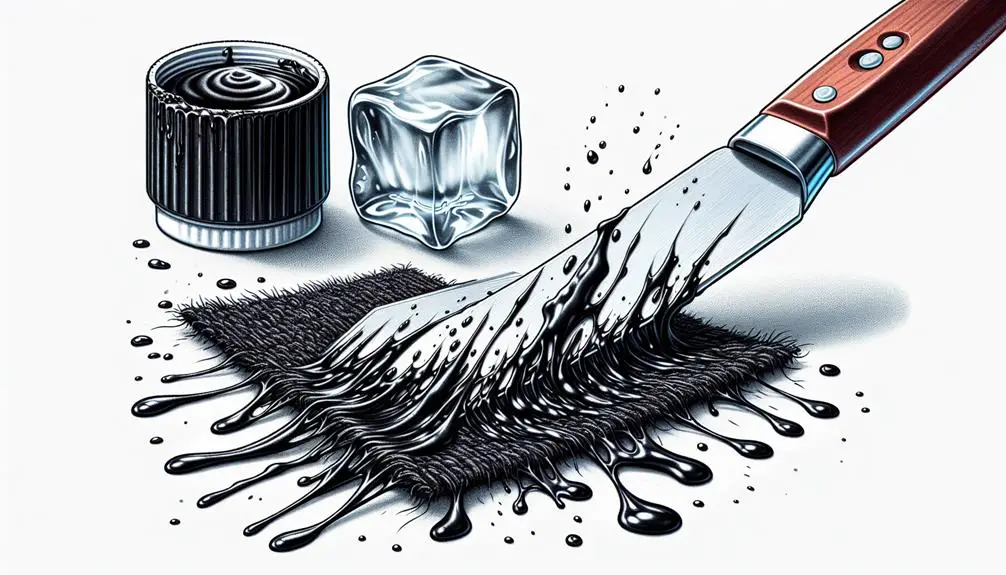When faced with the sticky situation of tar on fabric, it can feel like an impossible task to tackle. However, with a few simple steps and the right approach, this pesky problem can be resolved efficiently.
From utilizing common household items to understanding the science behind stain removal, there are various methods to explore.
So, if you've ever wondered how to bid farewell to tar stains for good, stick around to uncover the secrets to successful fabric restoration.
Table of Contents
Key Takeaways
- Pre-treat tar stains with oil-based products to break them down effectively.
- Use heavy-duty detergent to lift stubborn tar stains from fabric.
- Test cleaning solutions on a small area to prevent color damage.
- Employ proper techniques and materials for successful tar stain removal.
Understanding Tar Stains on Fabric
When dealing with tar stains on fabric, understanding their stubborn and oily nature is crucial for successful removal. Tar, commonly present in asphalt products used in construction, can be a nightmare to tackle when it finds its way onto clothing.
The key to effectively removing tar stains lies in employing the right techniques and materials. Pre-treating the affected area with oil-based products helps break down the stain, making it easier to lift from the fabric. To aid in the removal process, using a heavy-duty laundry detergent specifically designed for tough stains can be immensely beneficial.
However, caution is advised when using such products, as they can be potent and might affect the fabric's color. Testing any cleaning solution on a small, inconspicuous area of the fabric first is a smart practice to ensure that the color remains intact throughout the stain removal process.
Necessary Tools and Materials
Let's equip ourselves with the necessary tools and materials to effectively tackle tar stains on fabric. To begin, you'll need a dull knife to gently scrape off excess tar without damaging the clothing fibers. A soft-bristled brush is also handy for loosening any remaining tar residue. Ice cubes play a crucial role in this process by hardening the tar stain, making it easier to remove.
For effective stain removal, a heavy-duty detergent is essential. This powerful cleaner will help break down the tar's oily residue, preparing the fabric for a deeper clean. Additionally, consider using oxygen-based bleach to treat any discoloration left behind by the tar stains.
Freezing the Tar for Removal
I've found that freezing tar stains with ice cubes before removal can be a game-changer. By hardening the tar, it becomes much simpler to scrape it off fabric without causing damage.
Plus, once the tar is solid, laundering the fabric can help get rid of any remaining residue.
Chilling the Tar
To effectively remove tar from fabric, begin by chilling the tar using ice cubes to harden it for easier removal. Chilling the tar has its perks, and I want to share some key tips with you:
- Placing ice cubes in a plastic bag can prevent excess moisture on the fabric.
- The cold temperature from the ice cubes solidifies the tar, reducing its stickiness.
- Using ice cubes is a safe and effective method for chilling tar stains.
- Hardening the tar with ice cubes before scraping helps prevent spreading the stain.
- Freezing the tar makes it less challenging to remove, saving time and effort.
Scraping It off
Consider placing an ice-filled plastic bag directly over the tar stain on the fabric to freeze and harden it for easier removal. The freezing method helps solidify the tar, making it less sticky and simplifying the scraping process.
By using ice cubes, you can scrape away as much of the frozen tar as possible, reducing the risk of spreading the stain further. This technique is a beneficial initial stain treatment before proceeding with additional cleaning steps.
The cold temperature from the ice cubes aids in hardening the tar, allowing for a more efficient removal process. Remember to be gentle while scraping to avoid damaging the fabric.
This simple yet effective method can be a game-changer in dealing with tough tar stains on fabric.
Laundering the Fabric
For optimal tar removal from fabric, start by freezing the tar using ice cubes to make it easier to remove. Ice cubes can be a game-changer when dealing with stubborn tar stains on clothing.
Here are a few tips to effectively freeze and remove tar from fabric:
- Place ice cubes in a plastic bag and apply them directly to the tar stain.
- The cold temperature from the ice helps solidify the tar, making it less sticky.
- Harden the tar stain with ice before attempting to scrape or treat it further.
- This method is highly effective in preparing the fabric for the tar removal process.
- Remember to be gentle when scraping off the hardened tar to avoid damaging the fabric.
Using Stain Removers Effectively
When it comes to effectively dealing with tar stains on fabric, the key lies in choosing the right stain remover and mastering proper application techniques.
Opting for a heavy-duty detergent with potent stain-fighting abilities can make a significant difference in the removal process.
Remember to apply the stain remover directly to the affected area and follow through with a methodical approach for best results.
Choosing the Right Product
To effectively choose the right product for removing tar from fabric, focus on selecting heavy-duty stain removers specifically designed for tar removal. When dealing with tough stains like tar, it's essential to use products that can break down the oily residue effectively.
Here are some tips for choosing the right product:
- Look for heavy-duty stain removers tailored for tar removal.
- Consider using oxygen-based bleach to tackle any discoloration from the tar stain.
- Try pre-treatment methods like a paste of baking soda and water for enhanced stain removal.
- Opt for Persil® ProClean® OXI Power detergent with OXI Power technology for optimal cleaning of tough tar stains.
- Always follow the garment care label instructions for washing and drying to ensure effective tar stain removal while preserving the fabric.
Application Techniques
I recommend starting the sentence like this:
Gently scrub the affected area with a soft-bristled brush to ensure the stain remover penetrates the fabric fibers effectively. Once the stain remover is applied, let it sit on the fabric for the recommended time to allow it to break down the oily residue from the tar stain.
For a more thorough cleaning process, consider using a heavy-duty detergent in conjunction with the stain remover. If the fabric is machine washable, follow up by laundering it according to the garment's care instructions.
In some cases, hydrogen peroxide can be a helpful addition to the stain removal process, but always test it on a small, inconspicuous area first to ensure compatibility with the fabric. Remember to follow the manufacturer's instructions on the stain remover for optimal results.
Applying Heavy-Duty Detergent
Let's dive into how heavy-duty detergent works wonders in eliminating stubborn tar stains from fabric. When dealing with tough tar stains, heavy-duty detergent can be a game-changer. Here's how it helps in the removal process:
- Breaks Down Tough Stains: Heavy-duty detergent contains strong cleaning agents that effectively break down and dissolve the oily tar residue embedded in the fabric fibers.
- Lifts Stubborn Stains: The powerful cleaning properties of heavy-duty detergents help lift and remove even the most stubborn tar stains from the fabric.
- Penetrates Fabric: By scrubbing the affected area with heavy-duty detergent, you can ensure that the detergent penetrates the fabric, targeting the tar stain more effectively.
- Designed for Difficult Stains: Heavy-duty detergents are specifically formulated to tackle challenging stains like tar, providing a deep cleaning action that regular detergents may not achieve.
- Thorough Cleaning: Using heavy-duty detergent ensures a thorough cleaning process, helping to restore the fabric to its original state by eliminating all traces of tar.
Treating Discoloration After Tar Removal
Transitioning from the effective use of heavy-duty detergent in removing tough tar stains, addressing discoloration after tar removal is crucial to restoring the fabric's original appearance. If the stain still lingers or has left the fabric looking dull, it's time to roll up your sleeves and put in some elbow grease.
Step 3: Wash. Use a stain-specific oxygen-based bleach to treat the discolored area. This type of bleach can work wonders in restoring the fabric's original color post-tar removal. The oily nature of tar stains can sometimes lead to discoloration, but with the right treatment, the fabric can look as good as new.
After treating the discolored area, make sure to thoroughly rinse the fabric to remove any remaining bleach residue. Follow up with a gentle wash cycle, and opt for air-drying to help maintain the fabric's appearance. Remember, a little extra care can go a long way in reviving your fabric after tar removal.
Additional Tips for Tar Stain Removal
When it comes to tackling stubborn tar stains on fabric, quick removal methods are key.
From utilizing frozen veggies to making a baking soda paste, there are various ways to effectively lift tar stains.
Additionally, implementing preventive measures can help avoid future staining mishaps.
Quick Tar Removal Methods
Using household products like baby oil or club soda can effectively pre-treat fabric with tar stains, preparing them for easier removal. Here are some quick methods to help you tackle those stubborn tar stains:
- Harden tar stains with ice cubes before removal.
- Utilize heavy-duty laundry detergent for tough stains.
- Create a paste with baking soda and water for added cleaning power.
- Consider using Persil® ProClean® OXI Power detergent for effective stain removal.
- Avoid drying garments until tar stains are completely eliminated to prevent setting and make the removal process smoother.
Preventing Future Stains
To further enhance your efforts in keeping tar stains at bay, let's explore additional tips for preventing future stains.
Applying a stain repellent spray to fabrics can create a protective barrier against tar stains, making them easier to remove.
Avoid walking on freshly laid asphalt to prevent picking up tar on your clothing.
Utilize protective covers or old towels when sitting or leaning against surfaces with tar to avoid staining.
Promptly treating any tar stains is crucial to prevent them from setting and becoming more difficult to remove.
Regularly inspect and clean your shoes to prevent tracking tar indoors and onto fabrics, reducing the chances of staining.
Utilizing Household Products for Cleaning
I often find that household products are incredibly useful for tackling tough cleaning tasks, especially when it comes to removing tar stains from fabric. Here are some effective household products you can use to clean tar stains:
- Baking Soda: Make a paste with baking soda and water, then apply it to the tar stain before washing.
- Dish Detergent: Use dish detergent to break down the tar stain before laundering the fabric.
- Enzyme Laundry Detergent: This type of detergent can help break down tough tar stains on fabric.
- Dawn Dish Soap: A safer alternative to harsh chemicals like WD-40, Dawn dish soap is effective at removing tar stains.
- Club Soda: While not a household product per se, club soda can be effective for removing fresh tar stains from fabric.
These household products are readily available and can be effective at tackling stubborn tar stains on your favorite fabrics.
Checking Garments Post-Treatment
After effectively utilizing household products for cleaning tar stains from fabric, the next step involves thoroughly checking the garments post-treatment to ensure complete removal of the stains.
To begin, inspect the treated area under good lighting to verify that the tar stain is entirely gone. Look closely for any residual discoloration or remaining tar residue on the fabric, as these can be easily missed.
Check the affected area for any lingering odor, which could indicate traces of tar left behind despite the cleaning process. Additionally, run your fingers over the fabric to feel its texture and ensure it's smooth, free of any sticky or oily residue that might suggest incomplete removal.
Remember to check the tag for specific care instructions post-treatment. Finally, make sure the garment is completely dry before storing or wearing it to prevent any reoccurrence of stains on your clothing.
These steps will guarantee a thorough and successful tar removal process.
Exploring Tar Removal FAQs
Curious about removing tar stains from fabric? Here are some frequently asked questions to guide you through the process:
- Can I use a bag of frozen vegetables to harden the tar before removal?
Using a bag of frozen vegetables can help solidify the tar, making it easier to scrape off. Just be sure to wrap the bag in a cloth to prevent moisture from damaging the fabric.
- Should I wear gloves when handling tar removal products?
It's essential to wear gloves to protect your skin from harsh chemicals and potential skin irritation. Always prioritize safety when dealing with stain removers.
- How can I make sure the tar is completely removed from the fabric?
After treating the stain, thoroughly inspect the fabric under good lighting to ensure no residue remains. Reapply treatments if needed before washing.
- Is it advisable to use a soft brush during the scrubbing process?
Yes, using a soft brush can help loosen the tar without damaging the fabric. Gently scrub the affected area to avoid spreading the stain further.
Best Practices for Preventing Tar Stains
To prevent tar stains on fabric, it's crucial to be mindful of your surroundings and take proactive measures to avoid contact with tar-containing surfaces. One way to prevent tar stains is by avoiding walking on freshly paved surfaces where tar may be present. Additionally, using protective measures such as shoe covers or tarps when working with tar can help minimize contact with clothing. If you do encounter tar stains, promptly treating them with recommended cleaning techniques can prevent them from setting and becoming more challenging to remove. Consider wearing old or disposable clothing when working in areas with potential tar exposure to protect your favorite garments. Regularly inspecting and cleaning tools and equipment used around tar can also help prevent transferring stains onto fabric. By being aware of these preventive measures and taking proactive steps, you can significantly reduce the likelihood of dealing with stubborn tar stains on your fabrics.
| Protective Measures | Cleaning Techniques | Preventing Stains |
|---|---|---|
| Use shoe covers or tarps when working with tar | Promptly treat tar stains | Avoid walking on freshly paved surfaces |
| Consider wearing old or disposable clothing | Follow recommended cleaning techniques | Use tools and equipment carefully |
Frequently Asked Questions
Does WD-40 Remove Tar From Clothes?
Oh, WD-40? It's like a superhero for tar stains on clothes! Just spray, rub gently, and voilà – tar's gone! Remember to wash afterward to keep your fabric safe. WD-40 saves the day!
Does Vinegar Remove Tar?
Vinegar isn't the best for tar removal from fabric. It may struggle with tar's oily nature. Try dish soap, laundry detergent, or stain removers instead. Pick the right cleaner for success. Dry cleaners or guides can help too.
What Removes Tar Easily?
Tar removal made easy with ice cubes to harden, orange cleaner as pre-treatment, and a mix of dish soap, detergent, baking soda, and peroxide for washing. Soak in hot water, then air dry for spotless results.
How Do You Get Tar Out of a Fabric Couch?
To get tar out of a fabric couch, I recommend using ice to harden the tar, then gently scraping it off. Apply a stain remover or WD-40 to break it down, clean with detergent, scrub, and rinse thoroughly with hot water.
- The Use of Nonwovens in Construction and Civil Engineering - July 11, 2025
- The Use of Nonwovens in Construction and Civil Engineering - July 11, 2025
- The Use of Nonwovens in Construction and Civil Engineering - July 11, 2025







